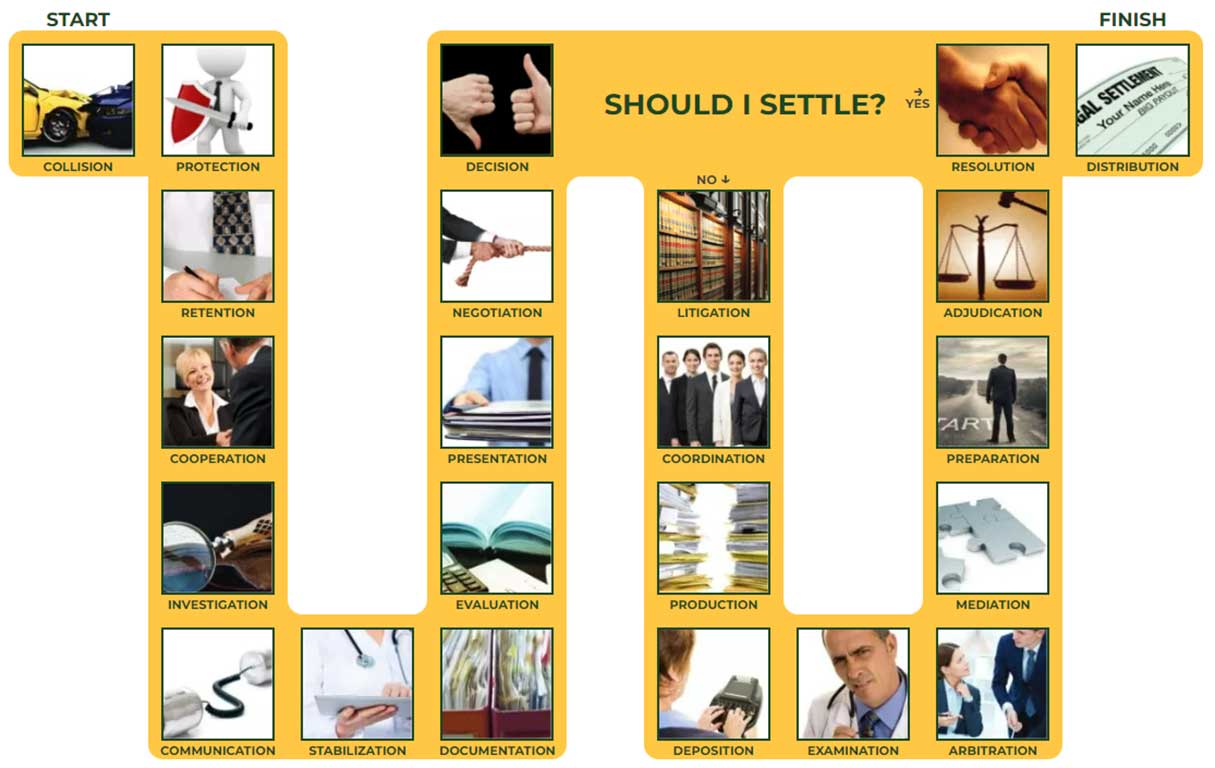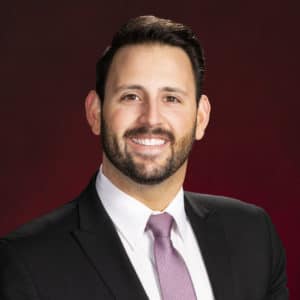Our Personal Injury Case Resolution Process
THE CASE RESOLUTION PROCESS
The timeline of a personal injury case can be complex and emotionally draining. At the Richard Harris Law Firm, we have proven Case Resolution Process™ to ensure our team is communicating and preparing you for each stage and the best possible settlement.

What to do after an accident
They need to go to their doctor’s appointments as instructed by the doctor. They should not miss appointments. They should avoid rescheduling appointments too frequently unless there is an emergency situation that comes up.
How soon should i hire lawyer?
It’s not too soon to hire a lawyer a day or two after an accident if the injuries are severe; if there’s going to be a dispute in liability.
There’s a lot of work to be done by a personal injury lawyer right from the beginning. So delay only plays into the hand of the insurance company. It’s important for folks to get a lawyer, and get it done.
Choosing the right lawyer
I would ask the lawyer what his jury trial experience has been; whether he has been successful in court—whether he’s been in court at all. I would ask how many cases the lawyer has successfully resolved—whether he has studied negotiation and mediation law, which ends up being the critical way to settle over 95 percent of the cases that are out there. I would ask what the financial resources of the firm are—whether the law firm is willing to advance all client costs of litigation, so that the client doesn’t have to come out of pocket at all.
I would ask a lawyer what his or her disciplinary record is with the state bar—whether the lawyer’s been reprimanded, suspended, or disbarred at any time. I would ask whether the law firm has received referrals from other lawyers, whether the law firm has received referrals from judges or insurance adjusters or insurance defense lawyers who would have special knowledge of abilities of every lawyer.
I would ask those questions to help make a decision on whether this lawyer has the professional ability to successfully resolve the case. But I would also ask myself, if I were a client, whether I click with this lawyer: Is this somebody that I can get along with? Is this somebody that I can feel like I can open up and share the facts of the accident—the difficulties that I’m suffering? That he’s accessible? That he listens to me? That he calls me back? That he communicates with me, with understanding, with care, and empathy?
I think all of those things are great, important, and serious factors to consider when anyone chooses a lawyer. No one should choose a lawyer based upon advertising alone. No one should choose a lawyer based on their track record alone. But I think those two factors rolled into one, are the most important ways to evaluate whether this lawyer is right for you.
The initial meeting
So once the initial call has been made, an appointment is set. The injured perspective client comes to our office. They are placed in a conference room, and they’re asked to bring with them, beforehand, all of the materials that have anything to do with their case up to that point.
For an auto accident case, that usually consists of the driver exchange information—the little ticket that’s given to them by the investigating police agency that gives some basic information about the case. They may come with their own insurance information, with any kind of bills or receipts, their initial medical care, their pharmacy prescriptions, and so forth.
They are first interviewed by a case manager, who takes more information about the case: the basic personal information, the contact information, general facts of the accident, run down of the injuries, the potential liability of the responsible party, is all taken down in a general sense. And then the individual is joined by an attorney who continues the interview process.
The fee arrangement is explained—the retainer agreements, the contingency fee contract is presented to the client. It’s gone over in great detail by the lawyer, and where there’s an agreement on the terms, the client retains our law firm, signs the retainer agreement, and any authorizations for the release of medical information, lost earnings information, and so forth.
The process is explained in detail to the client of what to expect—the very stages of a personal injury case. And once that meeting is concluded, the work begins. The client is asked to remain in contact with our law firm, to follow up appropriately with medical care and treatment, to advise us of any changes in medical treatment or injuries.
And to communicate with us is also a two-way street, where we provide the clients, frequently, with updated information concerning what we have found with the respect to the investigation of the case, collection of the documentation necessary to present the case—then, hopefully within a few months, and in most cases, the successful negotiations and conclusion of the case.
The legal process
Most of our cases resolve in the negotiation phase. However, when there’s a dispute concerning liability, who’s to blame for the accident, or whether there’s just simply a disagreement between our law firm and the insurance company on the value that would fairly resolve that case, then a lawsuit is required. And in those cases, the lawsuit goes through various stages.
One of them is the discovery phase, which is an exchange of information between the law firm that represents the injured victim and the defense firm who represents the interests of the insurance company. And there’s an exchange of information, both in written form—in the form of requests for production of documents back and forth—and interrogatories, which are written questions that must be answered by the injured person and the defendant—the responsible party—under oath, determining certain facts of the case.
Beyond the documents that are exchanged and the written answers to questions are depositions, which are a sworn testimony under oath taken in the presence of a court reporter in order to determine not only the facts of the case—how the accident happened from the standpoint of the police officers and witnesses and parties involved—but also the injured victim is called upon to testify concerning how the accident affected them from the standpoint of their injuries, the pain and suffering, their lost earnings, and so forth.
And also, medical doctors and other providers of health care are called upon to give sworn testimony in depositions in order to explain exactly what happened as far as the injury is concerned and what it took to get the injured victim better—back on his or her feet again. So in the process of discovery, our clients can expect to hear from our office frequently concerning information that we need from them in the form of documentation, in the form of cooperation in answering these sworn questions under oath. And also in the deposition setting, which is verbal exchange of information in the presence of a court reporter.
There may be an arbitration proceeding in order to resolve the case, there may be a mediation proceeding, which is facilitated negotiations in the presence of a neutral who’s called upon to help bring the parties together. And then if none of those resolve the case, then there’s the jury trial, which is the presentation of the case in an adversarial format with lawyers for both sides in the presence of a judge and a jury in order to determine the facts of the accident, in order to assess liability, and to determine a fair amount of compensation for the person who’s been injured.
Social media effects
Certainly, doctors and other medical providers need to be involved. But one of the mistakes that some people make are that they talk too much about their accident, and they can say the wrong thing, which may be misconstrued by a neighbor or an acquaintance, which can be used against them by the insurance company.
In the last few years, particularly with the advent of social media, people are opening up their lives to the world. They’re posting on Facebook and other social networking sites and talking about everything in their lives like an open book. And one of the problems with that is that when they talk about their accident and say some offhand remark, they have to be aware the insurance company and their representatives and their lawyers are monitoring social networking sites.
They’re sending investigators to talk to neighbors and acquaintances to see if they can find information about the injured person that could be used against them. And then these insurance companies and their lawyers selectively use that information to try to discredit the injured person to diminish the value of the case.
So I would say that for a client to have a better chance of success after being injured in an accident, they should keep their information private. They should discuss their injuries and the effects of the accident on them only with the closest family members and friends.
The legal system
And by seeing the other side’s point of view, you’re able to get below the line and develop the ability to predict with reasonable certainty what would happen to this case if it went to trial. If a jury were able to hear this case, what is their likely result? And because of that ability that lawyers have, through their experience and through the discovery process where almost all information is shared between the two sides, most lawyers are able to sit down and resolve cases fairly.
Sometimes it takes a phone call, sometimes it takes a series of letters, sometimes it takes a face-to-face meeting, either in the context of an informal get-together or the formality of the mediation process where there is facilitated negotiations going back and forth through a neutral mediator who’s been retained by both sides and try to help people see that common ground. So above all, we must respect the system.
Above all, we must respect that this is the best way that we can resolve disputes in America through the civil justice system, which requires people to be aggressive, but it also requires them to be respectful to each other; otherwise, the system is entirely undermined.
Documentation we need
It’s also important to have documentation concerning lost earnings verified by the employer; verified by the doctor who disabled the client for a period of time. Also, we need witness statements from our clients who can give us information about how the accident affected our client’s life in the form of pain, suffering, inconvenience, and so forth.
When that information is gathered, it allows the attorney representing the injured victim the ability to negotiate effectively. And, in a sense, the case speaks for itself. And the professional who is negotiating on behalf of a client can bring up the points that are necessary to make sure there’s adequate compensation for each element of damage: medical, lost earnings, pain and suffering, and so forth.
Negotiating a settlement
Usually, there’s not a particular single amount that a case needs to settle for. Once all the information is gathered, all the documentation obtained by our office, once we know all the facts and circumstances of the case, then we are able to put a range of value on a case.
From this amount to that amount, within a reasonable range, we would be willing to settle that case for. Once we get settlement offers within that range, we recommend settlement to our client. If the settlement offers are not within that range of settlement, we look at other forms of determining liability and the extent of damages through the litigation process.
So we convey all settlement offers to our clients. We give them advice on whether they should accept or decline the offer, keeping in mind the time value of money, keeping in mind the extra expense that is necessary to litigate a case as opposed to negotiate. All of these factors are considered by our law firm and the client as we determine the best course of action for our client.
Preparing for trial
This can be a very daunting, intimidating situation for our clients who aren’t used to having a lawyer, let alone going to court in a trial. I tell my clients that trial is really the last place you want to be, because at that point, you’ve lost control.
In the context of negotiating your case, there’s still some control about whether you say yes or no to a settlement offer. In the context of a mediation process, where a neutral professional is called upon to help the parties get together and try to find that common ground and resolve the case, there’s still an element of control.
When a case goes to trial, there’s a loss of control in the sense now that you’re leaving everything up to the judge or the jury in order to determine the facts of the case, the liability of the parties, and question of damages.
What I tell clients, most importantly, before that day in court, is to be real, be yourself, to be honest, to let the essence of what they have been through rise to the top. Because people feel that sincerity; people feel that emotion that goes through a person when they get involved in an accident.
If they don’t try to hide anything; if they let their emotions flow about the way that the accident has affected them; if they let down their guard and be real, there’s a connection that occurs that everyone feels.
And I believe that the truth rises to the top. In most cases where the client’s been honest and have been forthcoming in the way that they tell their story, the attorney then is able to advocate successfully to the judge or jury in order that justice be served, and there can be a fair award of damages.






























